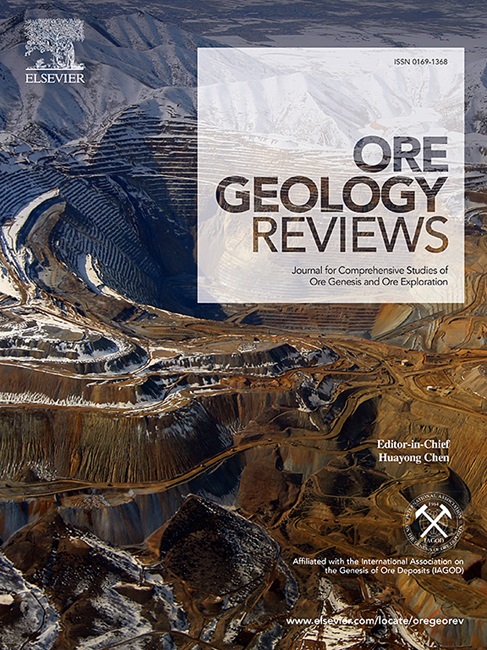Mineralogy and geochemistry of two stages of uranium mineralization in the Jiling albitite-hosted uranium deposit, northwest China
IF 3.2
2区 地球科学
Q1 GEOLOGY
引用次数: 0
Abstract
The Jiling Na-metasomatism uranium deposit in northwest China was initially regarded as a low-temperature mineralized system. Recent exploration has identified high-temperature mineralization at depth. However, the genesis of high-temperature U mineralization at Jiling remains unclear, resulting in the absence of a comprehensive genetic model for the Jiling deposit. This study integrates whole-rock geochemistry, mineral paragenesis and chemistry, and stable and radioactive isotope compositions from unaltered, altered, and ore-bearing samples to characterize five stages of magmatic and hydrothermal evolution at Jiling: (1) the first stage involved the emplacement of the Jiling high-K calc-alkaline granitoids, representing the primary uranium source for mineralization; (2) Na-metasomatism stage is characterized by the albitization accompanied by ductile deformation. The alteration assemblage includes albite, hematite, and chlorite. U–Pb dating of apatite from ore-barren albitite yielded an age of 433 ± 14 Ma. Stable isotopes of albite and chemical compositions of apatite indicate that the metasomatic fluids were high-temperature, Na-enriched, and alkaline, likely exsolved from the mafic dykes in the Jiling area; (3) Na-Ca-metasomatism followed immediately after Na metasomatism. This stage, characterized by weak brittle deformation of the albitite, is associated with high-temperature uranium mineralization. Alteration assemblage includes albite and calcite, with uraninite as the primary uranium mineral. Uranium was transported by a high-temperature, alkali-rich, alkaline, and reducing fluid, primarily as hydroxide complexes. The removal of Na and Ca from the fluids destabilized uranium complexes, leading to uraninite precipitation; (4) Ca-Fe-Mg-metasomatism, occurring during the Middle Devonian, is associated with the low-temperature uranium mineralization. Alteration minerals include calcite, chlorite, hematite, and barite. Pitchblende is the dominant uranium mineral. Metasomatic fluids were primarily meteoric water with a minor magmatic component. Uranium was likely transported as uranyl sulfide complexes; (5) the post-ore alteration stage contains calcite, chlorite, illite, and quartz. During this stage, uraninite and pitchblende were partially or totally altered into coffinite. By delineating these five stages, this study provides a comprehensive genetic model for the Jiling deposit, elucidating the processes and conditions leading to high- and low-temperature uranium mineralization. These findings highlight the crucial role of initial high-temperature, alkali-rich magmatic fluids in high-temperature uranium mineralization and subsequent meteoric water in low-temperature uranium mineralization of the Jiling deposit. This understanding will facilitate the development of precise ore-forming models for future exploration at the Jiling deposit.

芨岭钠长岩型铀矿床两期铀矿化的矿物学和地球化学特征
滇西北芨岭钠交代铀矿床最初被认为是一个低温成矿系统。最近的勘探在深部发现了高温矿化。然而,吉尔岭高温铀成矿成因尚不清楚,导致吉尔岭矿床缺乏全面的成矿模式。综合全岩地球化学、矿物共生化学以及未蚀变、蚀变和含矿样品的稳定同位素和放射性同位素组成,刻画了吉岭岩浆和热液演化的5个阶段:(1)第1阶段吉岭高钾钙碱性花岗岩侵位,是成矿的主要铀源;(2)钠交代阶段以钠长石化为主,并伴有韧性变形。蚀变组合包括钠长石、赤铁矿和绿泥石。无矿钠长石中磷灰石的U-Pb年龄为433±14 Ma。钠长石的稳定同位素和磷灰石的化学组成表明,其交代流体为高温、富钠、碱性流体,可能来自于鸡陵地区的基性岩脉;(3)钠交代后立即发生Na- ca交代。这一阶段以钠长岩的弱脆性变形为特征,与高温铀矿化有关。蚀变组合包括钠长石和方解石,其中原生铀矿物为铀矿石。铀通过高温、富碱、碱性和还原性流体主要以氢氧化物的形式输送。流体中Na和Ca的去除使铀配合物不稳定,导致铀精矿析出;(4)中泥盆世ca - fe - mg交代作用与低温铀矿化有关。蚀变矿物包括方解石、绿泥石、赤铁矿和重晶石。沥青铀矿是主要的铀矿物。交代流体主要是有少量岩浆成分的大气水。铀可能以铀酰硫配合物的形式运输;(5)矿后蚀变阶段含方解石、绿泥石、伊利石和石英。在这一阶段,铀矿和沥青铀矿部分或全部蚀变为铀矿。通过对这五个阶段的圈定,建立了鸡岭矿床的综合成因模式,阐明了高低温铀矿化的过程和条件。这些发现凸显了初始高温富碱岩浆流体在高温铀矿化中的重要作用,以及后续大气水在鸡岭矿床低温铀矿化中的重要作用。这一认识将有助于建立精确的成矿模式,为今后在鸡岭矿床的勘探奠定基础。
本文章由计算机程序翻译,如有差异,请以英文原文为准。
求助全文
约1分钟内获得全文
求助全文
来源期刊

Ore Geology Reviews
地学-地质学
CiteScore
6.50
自引率
27.30%
发文量
546
审稿时长
22.9 weeks
期刊介绍:
Ore Geology Reviews aims to familiarize all earth scientists with recent advances in a number of interconnected disciplines related to the study of, and search for, ore deposits. The reviews range from brief to longer contributions, but the journal preferentially publishes manuscripts that fill the niche between the commonly shorter journal articles and the comprehensive book coverages, and thus has a special appeal to many authors and readers.
 求助内容:
求助内容: 应助结果提醒方式:
应助结果提醒方式:


